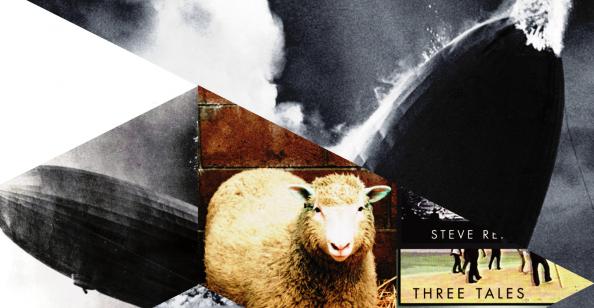
Three Tales recalls three well known events from the early, middle and late 20th century, Hindenburg, Bikini, Dolly. Each of these reflects on the growth and implications of technology during the 20th century from early air transport to the current ethical debate on the future of our species. This debate, about the physical, ethical and religious nature of the expanding technological environment has continued and grown pervasive since 1945.
The first tale, Hindenburg, utilizes historical footage, photographs, specially constructed stills and a videotaped interview which provide a setting for the archival material and text about the zeppelin. Starting with the final explosion in Lakehurst, New Jersey in 1937 it also includes material about the zeppelin's construction in Germany in 1935 and its final Atlantic crossing. The unambiguously positive attitude towards technology is presented through newscasters of the era.
The second, Bikini, is based on footage, photographs, and text from the Atom bomb tests at Bikini atoll in 1946-1954. It also tells of the dislocation and relocation of the Bikini people, living totally outside the Western world which determined their fate. While Hindenburg is presented more or less chronologically in four discreet scenes with silence and black leader separating them, Bikini is arranged in three image/music blocks that recur in a nonstop cycle repeated three times forming a kind of cyclical meditation on the documentary events. A short coda explores the period of time after the explosions and ends the tale. Interspersed throughout are the two stories of the creation of human beings from Genesis. Not sung, but rather 'drummed out' by the percussion and pianos as if they existed (as indeed they do) in another dimension.
The third tale, Dolly, will briefly show footage, text and interview comments about the cloning of an adult sheep in Scotland in 1997. It will then deal extensively with the idea of the human body as a machine, genetic engineering, technological evolution and robotics. While Hindenburg uses only one 'cameo' interview from the present to comment on the past and Bikini uses none, Dolly will be filled with interview fragments from members of the scientific and religious communities. Interviewees include; Dr. James D. Watson, Richard Dawkins, Stephen Jay Gould, Rodney Brooks, Marvin Minsky, Steven Pinker, Sherry Turkle, Bill Joy, Jaron Lanier and Rabbi Adin Steinsaltz among others. Though similar to the earlier The Cave in the use of interviews, new formal treatments of the interview fragments lead to very different results. Specifically, "slow motion sound" (an idea Reich had in the 1960s but which is only now technically possible) allows one to see and hear people speaking in slow motion without changing the pitch of what they say. Another new technique, "freeze frame sound" is the sound equivalent of a film freeze frame in that a single vowel or consonant is extended for a long time leaving a kind of audible vapor trail behind each speaker that becomes part of the overall harmony. In addition, a talking robot has an important role. The two versions of the creation of human beings, the Tree of Knowledge, and other Biblical material, are presented in various ways. Different attitudes towards the science and technology we so avidly embrace, are embedded in the interview fragments, including a religious perspective not heard in public discussion.
Three Tales is a new kind of musical theater in which historical film and video footage, video taped interviews, photographs, text, and specially constructed stills are created on the computer, transferred to video tape and projected on one large 32 foot screen. Sixteen musicians and singers take their place onstage below the screen. The completed work will run about 65 minutes.
Steve Reich, who has been called “America’s greatest living composer” (The Village Voice) and “the most original musical thinker of our time” (The New Yorker), has embraced not only aspects of Western classical music, but also the structures, harmonies, and rhythms of non-Western and American vernacular music—particularly jazz—throughout his career. His ensemble, Steve Reich and Musicians, regularly tours the world. Musical America named Reich, a two-time Grammy winner, Composer of the Year in 2000. Beryl Korot is an internationally exhibited artist who first became known for her early pioneering work in video art, particularly multiple-channel work. Her installations have been exhibited at New York’s Whitney Museum, the Leo Castelli Gallery, and The Kitchen, as well as the Dusseldorf Kunsthalle and Sofia Reina Museum (Madrid), among other venues. Reich and Korot previously collaborated on The Cave, a music theater video piece exploring the biblical story of Abraham, Sarah, Hagar, Ishmael, and Issac.